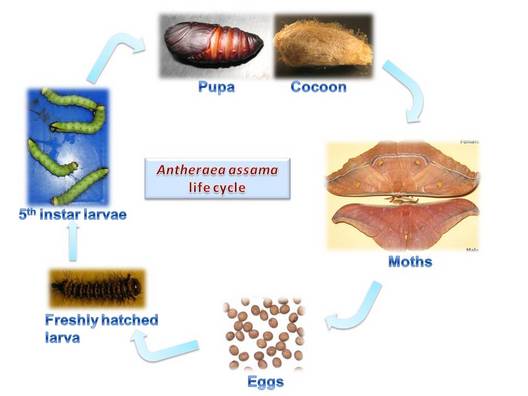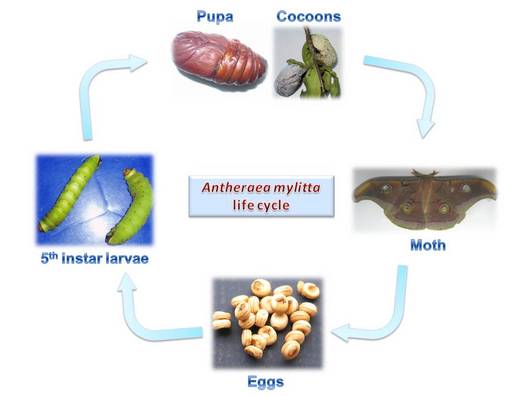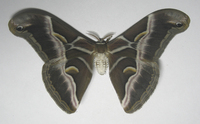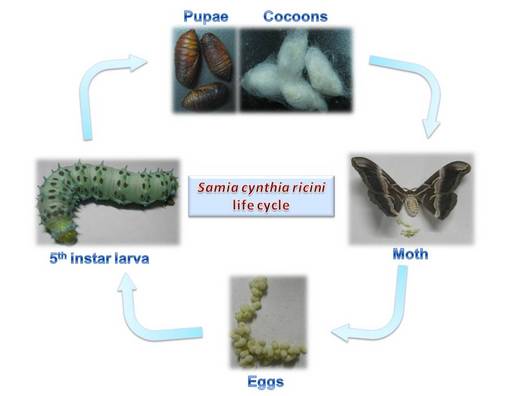 |
Information on Wild silkmoths
Non-mulberry sericigenous fauna belonging to the family Saturniidae (superfamily Bombycoidea) are mostly wild Silkmoths. These are used as important tools in basic entomological and biotechnological research in various countries. These are medium to very large in size, and this family includes the largest moths. Adults have a wingspan of 3 to 15 centimeters, relatively small heads, and densely hairy bodies. Larvae are usually very fleshy, with clumps of raised bristles. Caterpillars mostly feed on leaves of trees and shrubs; some cause severe damage. Pupa develops in silken cocoons. Wild silkmoths are reared on wild trees but can also be raised and bred under complete human control. They complete their life cycle of four different metamorphosing phases, egg, larva, pupa and adult (moths). Of this only larval stage is feeding period. The range of food selection of these insects is wide. Their cocoons are bigger than those of the domesticated silkworm.
|
Wild silkmoths include tasar silkworm, eri-silkworm, oak-tasar silkworm and muga silkworm. Most of the research and development of technology is confined to China, India, and Japan in Asia. The Indian tasar silkworm Antheraea mylitta is a natural fauna of tropical India, represented by more than 20 ecoraces. Large quantity of Indian and Chinese tasar cocoons are utilized to produce various types of textiles. Antheraea assama (Muga silkworm) (n= 15) is a wild silk moth mentioned in literature as early as 1662 BC. It is widely distributed and cultured in North-Eastern India particularly in Assam state. The golden-yellow muga silk is secreted by this semi-domesticated multivoltine species. Larvae fed on mejankori leaves (Litsea citrata) produce a kind of silk known as mejankori silk, which is favoured for its durability, lustre and creamy white shade. Japanese oak silkworm, Antheraea yamamai is a native of Japan with 31 chromosomes. It is also unique because it contributes to the production of a highly priced silk. Samia cynthia ricini (n= 13) a multivoltine silkworm commonly called as 'eri silkworm' is known for its white or brick-red eri silk. It is distributed in North-Eastern part of India. Its other ecoraces (~16) are distributed across the palaearctic and Indo-australian biogeographic regions. Antheraea pernyi (n=49) is originated in Southern China, dating back to the Han and Wei dynasties. Antheraea roylei (n=30,31,32) is distributed along the Sub-Himalayan belt of India. Antheraea proylei (n=49) is a successful hybrid of the Antheraea roylei with its chinese counterpart.
|
Among these wild silkmoths, we have analyzed transcriptomes of three economically important wild silkmoths. |
|
Scientific classification of wild silkmoths: |
- Kingdom : Animalia
- Phylum : Arthropoda
- Class : Insecta
- Order : Lepidoptera
- Family : Saturniidae
|
 Go to Top Go to Top |
|
 |
- Common name : Muga silkworm
- Genus : Antheraea
- Species : Antheraea assama
|
Chromosome number: n = 15 |
Muga silkworm is one of the economically important wild silkmoths whose genome is among the least understood is unique among saturniid moths. Native of Assam and named after Assamese word "muga" which indicates the amber (brown) colour of cocoon. It belongs to same family as Tasar. It is popular for its natural golden colour, glossy fine textures and durability. A. assama is an endemic species prevalent in the Brahmaputra valley and adjoining hills. It is a polyphagous insect, which feeds on leaves of Som, Soalu and other plants. By virtue of the narrow ecological distribution of host food plant, A. assama is confined to only Assam state of India. Empirical observations show that the population is declining due to depletion in genetic variability. The silk proteins of this species have not been studied so far despite their unique properties of providing golden luster to the silk thread.
|
Heterogeneity and sexual dimorphism with regard to colour pattern are less pronounced in A. assama than in A. mylitta because of its limited geographical distribution. The eggs of this species are streakless and brownish. The follicular imprints consist of a single pattern with oval main cells. The newly hatched larva is characterized by prominent black intersegmental markings over the yellowish body with brown head. After the first molt the body turns green, while the head remains brown. Yellow colour body larvae can also be seen. The pupa is copper brown, weighs about 6g. the cocoon is single shelled, light brown, oblong, closed, reelable and slightly flossy with a weak peduncle. The cocoon is golden brown or glossy white. The approximate body length of male moths is 3 cm and of the females 3.5 cm.
|
Antheraea assama life cycle |
 |
 Go to Top Go to Top |
|
 |
- Common name : Tasar silkworm
- Genus : Antheraea
- Species : Antheraea mylitta D
|
Chromosome number: n = 31 |
The word tasar apparently derives from the Sanskrit word trasara (Shuttle). Tasar silk is mentioned in literature dating back to 1590 B.C. The Indian tasar silkworm, Antheraea mylitta is a natural fauna of tropical India. Wide disritbution and polyphagy of this insect species had resulted in extensive variation in the population. As high as nineteen ecoraces have been reported in this species which feed primarily on Terminalia species and Shorea robusta and also on number of secondary food plants. The ecoraces are uni, bi or trivoltine depending upon the geo-ecological conditions and differ from each other in qualitative and quantitative traits. Tasar cocoons are reported to be largest among all the silk-producing insects in the world (Akai, 2000). Tasar silk fiber has its own distinctive color, is coarse to feel, but has higher tensile strength, elongation, and stress-relaxation values than the mulberry silk fiber secreted by Bombyx mori (Iizuka, 2000; Rajkhowa, 2000). These properties have made tasar silk as competent and desirable as mulberry silk.
|
The tasar larvae are stout and smooth, and have rudimentor scoli. The egg is oval, dorsoventrally symmetrical along the anteroposterior axis. About 3mm in length and 2.5mm in diameter, it weighs approximately 10mg. At oviposition it is dark brown owing to the gummy coating of meconium. Two brownish parallel lines along the equatorial plane of the egg divide the surface into three zones; disk, streak and edge. The larva is typically cruciform and has a hypognathous head with biting and chewing mouthparts. On hatching it is dull brownish yellow with black head. The body normally turns green and the head brown after about 48 hours, but also yellow, blue and almond-coloured larvae are met with occasionally. Body colouration is retained throughout the larval period. The pupa is obtect adectious, having a well-defined segmented body. The dark brown pupa weighs about 10 g. the ventral genital markings are on eigth and nonth abdominal segments. The cocoon is single-shelled, pendent, oval, closed and reelable, having a hard non-flossy shell with fine grains. At the anterior end there is a well formed dark brown peduncle with a ring at the distal end. The cocoons are generally yellow or grey. The females spin larger cocoons than the males. The moths exhibit distinct sexual dimorphism. The females are bigger, with a distended abdomen and narrow bipectinate antennae. The females are polymorphic in colour, being grey and yellow, whereas the males are brown. Yellow and grey males and brown females are rare.
|
In India, the production of tropical tasar silk remained next to mulberry silk for decades, constituting about 4 per cent of the total silk production. There is an ever-increasing demand for tasar silk owing to its strength, luster and copper brown colour. The tasar silk production has stagnated and declined in the recent past though the demand is increasing. The important reasons for low production are attributed to traditional method of silkworm rearing on tall trees in natural habitat, which exposes the larvae to a number of predators, parasites and diseases apart from natural vagaries. The wild sericigenous insects like tasar silkworms have in due course of time came to stay as semi-domestic for the regular efforts and interests that revolved round its economic utility.
|
Antheraea mylitta life cycle |
 |
 Go to Top Go to Top |
|
 |
- Common name : Eri silkworm
- Genus : Samia
- Species : Samia cynthia ricini
|
Chromosome number: n = 13 |
The name eri derives from the Assamese word ‘era’, which means castor-oil plant, the main food plant of this silkworm. Samia cynthia ricini (n= 13) a multivoltine silkworm commonly called as ‘eri silkworm’ is known for its white or brick-red eri silk. It is distributed in North-Eastern part of India, China and Japan. Its other ecoraces are distributed across the palaearctic and indo-australian biogeographic regions. The primary food plant of this polyphagous insect is castor (Ricinus communis L.), but it also feeds on a wide range of food plants such as Heteropanax fragrans, Manihot utilissima, Evodia flaxinifolia, Ailenthus gradulosa etc. The wild S. c. ricini silkworm completes one to three generations per year depending on geographical position and climatic conditions of the region, however, up to six generations occur in the domesticated cultures. Populations of S. c. ricini, that have been commercially exploited and are present in different regions of north-east India show wide morphological and quantitative variations in characters such as silk content, larval weight, cocoon weight, cocoon shell weight and silk ratio. Eri silkworms were successfully acclimatized in America and Europe, but could not take firm hold.
|
S. c. ricini shares basic characteristics of the saturniidae, but because of its different generic origin it has, as well, many characteristics which distinguish it from the species of Antheraea. The eggs are ovoid, candid white. The larva on hatching is greenish yellow. The body colour changes gradually to pure yellow by the end of the third day. From the third instar onward the body colour segregates into yellow, cream, green, blue or white. The fully mature larva is translucent and covered with a white powdery substance. Both spotted and unspotted larvae are found. The spots are of various types; single, double, zebra and semi-zebra. The obtect adectious pupa does not depart from the basic saturniidae pattern. It weighs about 2.6 g. the cocoon can be easily distinguished from those of antheraea as they ate elongated, soft wooly, peduncleless, open mouthed and unreelable. They exhibit colour polymorphism, being brick red and creamy white. The length of the male moth is about 2.3 cm and female is 3 cm. The average wing expanse of male and female moths is 13 cm and 15 cm.
|
Samia cynthia ricini life cycle |
 |
References:
- Non-mulberry silks, FAO agricultural services bulletin, 1979 (Published by Food and Agriculture Organisation of the United Nations).
- The Wild Silk Moths of North America by by Paul M. Tuskes, James P. Tuttle, Michael M. Collins (Cornell University Press).
- Butterflies and moths of North America
|
|
